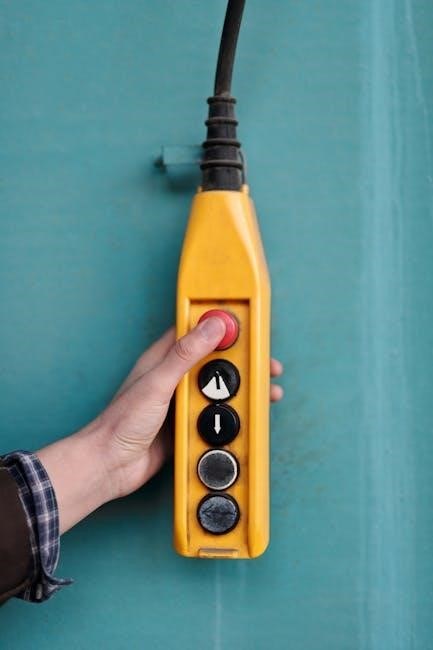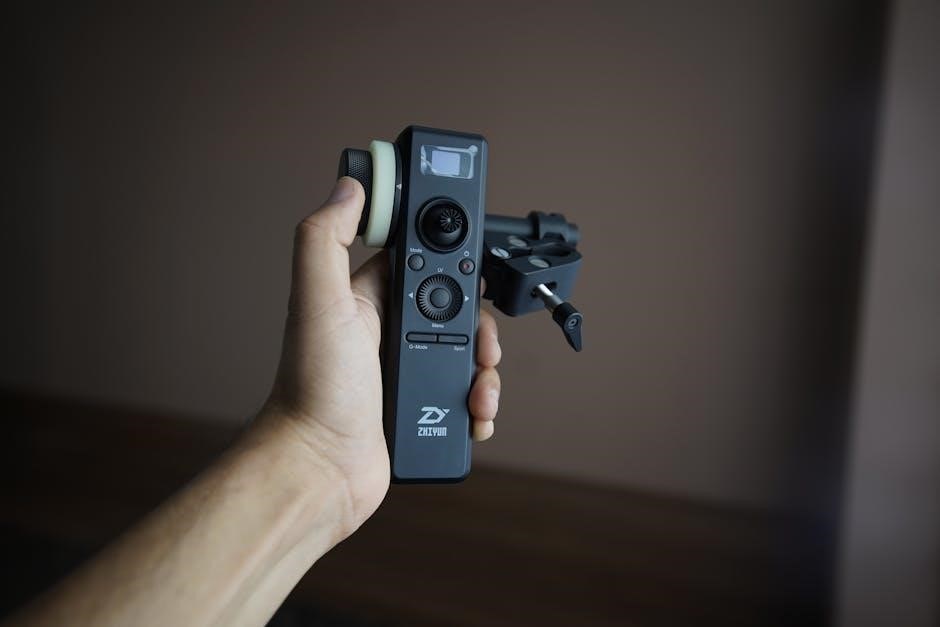MPPT solar charge controllers optimize energy harvesting from solar panels by tracking the maximum power point, ensuring efficient charging of batteries in various solar power systems.
1.1. Brief Overview of MPPT Technology
MPPT (Maximum Power Point Tracking) technology is an algorithm that optimizes energy extraction from solar panels by continuously tracking the maximum power point; It ensures efficient energy transfer to batteries by dynamically adjusting to varying solar conditions, unlike traditional PWM controllers. This advanced method enhances system efficiency, making it ideal for renewable energy applications, and improves overall performance in diverse environmental conditions.
1.2. Benefits of Using MPPT Solar Charge Controllers
MPPT controllers significantly improve energy efficiency by maximizing solar panel output. They offer higher charging speeds, better performance in varying conditions, and compatibility with diverse battery types. MPPT technology reduces energy loss, prolongs battery life, and enhances overall system reliability, making it a crucial component for optimizing solar power systems in both residential and industrial applications.

Key Components of an MPPT Solar Charge Controller
MPPT controllers consist of advanced hardware components and sophisticated firmware, enabling efficient energy tracking, voltage regulation, and battery management to optimize solar power conversion and storage systems.
2.1. Hardware Components
The hardware of an MPPT solar charge controller includes a DC-DC converter, PWM circuitry, voltage and current sensors, and communication interfaces. These components work together to regulate energy flow, optimize charging, and ensure system safety. Advanced models may also feature LCD displays, temperature sensors, and protection circuits for overvoltage, short-circuit, and reverse polarity. Together, these elements ensure efficient and reliable solar energy management.
2.2. Software and Firmware
MPPT solar charge controllers rely on advanced software and firmware to optimize performance. The software enables real-time monitoring, data logging, and customizable charging parameters. Firmware updates enhance efficiency, add features, and improve compatibility. Many controllers offer PC connectivity and mobile app integration for remote monitoring. These tools ensure precise control over energy management, making the system more efficient and user-friendly. Regular updates are essential for optimal performance and security.
Safety Precautions and Guidelines
Safety is crucial when handling MPPT controllers. Always disconnect power sources before installation and use appropriate fuses. Never operate the controller without reading the manual carefully to avoid potential electrical hazards.
3.1. General Safety Instructions
Always disconnect power sources before installation and ensure appropriate fuses are installed. Read the manual carefully to avoid electrical hazards. Never operate the controller without proper setup. Keep the manual for future reference and ensure all connections are secure to prevent overvoltages or short circuits. Wear protective gear when handling electrical components.
3.2. Voltage and Current Handling Precautions
Ensure all connections are secure and voltages are within specified ranges. Avoid overloading the controller by staying within its rated current capacity. Regularly check battery voltage settings to prevent overcharging. Use appropriate cables to handle current safely and prevent overheating.

Installation Steps for MPPT Solar Charge Controllers
Install the controller by securing it to a stable surface. Connect solar panels and battery according to the manual, ensuring all wires match the rated capacity and safety guidelines.
4.1. Pre-Installation Checks
Before installation, ensure all components are undamaged and compatible. Verify the MPPT controller’s power rating matches the solar panel and battery system. Check for loose connections and ensure the area is safe and dry. Review the manual to confirm compatibility with your battery type, whether lead-acid or lithium, and ensure voltage settings are correct. Proper preparation ensures a safe and efficient setup.
4.2. Connecting Solar Panels
Connect solar panels to the MPPT controller by following the manual’s wiring diagram. Ensure panels are configured in series or parallel to match the controller’s voltage and current ratings. Verify polarity, connecting positive to positive and negative to negative. Disconnect batteries and loads before connecting panels. Use appropriate fuses or circuit breakers to protect the system. Secure all connections tightly to prevent power loss.
4.3. Connecting the Battery
Connect the battery to the MPPT controller by attaching the positive terminal to the battery sense or positive input and the negative terminal to the negative input. Ensure the battery voltage matches the controller’s rating. Use appropriate cables and avoid reverse polarity. Turn off all loads and solar connections before connecting the battery to prevent system damage or electrical shock.
4.4. Final Wiring and Testing
After connecting all components, double-check wiring for accuracy and security. Power on the system and monitor the display for proper operation. Test charging and discharging functions under load. Ensure all safety features activate correctly and verify voltage and current levels align with specifications. Perform a full system test to confirm efficient energy transfer and battery management.

Configuration and Settings
Configure battery voltage, charge settings, and advanced options to optimize performance. Ensure settings match your system’s specifications for efficient solar energy management.
5.1. Setting Up Battery Voltage and Type
Ensure the controller is configured with the correct battery voltage (12V, 24V, or 48V) and type (lead-acid, lithium, or other). Navigate to the menu, select battery settings, and choose the appropriate options. Confirm compatibility and refer to the manual for specific instructions. Proper setup ensures optimal charging and prevents potential damage to the system.
5.2. Configuring Charge Settings and Limits
Set the charge voltage and current limits according to your battery’s specifications. Configure bulk, absorption, and float charge stages. Adjust maximum charge voltage and current to prevent overcharging. Use the manual to guide precise settings, ensuring compatibility with your battery type and capacity. Proper configuration optimizes charging efficiency and safeguards your system.
5.3. Advanced Configuration Options
Advanced settings include temperature compensation, custom charge curves, and communication interface configurations. Adjust parameters like equalization voltage and duration. Enable or disable features like night mode or load control. Use the manual to explore specialized options for optimizing performance. Ensure settings align with your system’s requirements for enhanced efficiency and reliability.

Monitoring and Maintenance
Regularly monitor the controller’s performance via its display or software. Perform routine checks for faults, clean connections, and ensure optimal operation. Update firmware as needed.
6.1. Monitoring Solar Charging Performance
Monitor the system’s performance using the controller’s LCD display or connected software. Track real-time metrics like voltage, current, and temperature. Ensure the controller is operating within specified ranges. Regularly check charging efficiency and adjust settings as needed. Use data logs to identify trends and potential issues. This helps maintain optimal performance and ensures reliable energy harvesting from your solar panels.
6.2. Regular Maintenance Tasks
Perform regular inspections of connections and cables to ensure they are secure and free from damage. Clean solar panels to maintain efficiency. Check the controller’s display for error codes and update firmware as needed. Inspect battery terminals for corrosion and tighten connections. Ensure proper ventilation to prevent overheating. Schedule annual professional checks to maintain optimal performance and longevity of the system.
6.3. Updating Firmware
Regularly update the controller’s firmware to ensure optimal performance and security. Download the latest version from the manufacturer’s website using a computer or provided software. Follow the manual’s step-by-step instructions to avoid errors. Verify compatibility before installation. After updating, test the system to ensure all features function correctly. Updates often improve efficiency, add new features, and fix bugs for reliable operation.

Troubleshooting Common Issues
Troubleshooting involves identifying and resolving issues like faulty connections, error codes, or performance problems. Refer to the manual for specific solutions and diagnostic steps to ensure proper functionality.
7.1. Controller Not Turning On
If the MPPT controller fails to turn on, check the battery connections, ensure proper wiring, and verify power supply. Inspect fuses or circuit breakers for faults. Ensure the battery voltage is within the controller’s acceptable range. Consult the manual for specific troubleshooting steps, including resetting the device or addressing error codes that may indicate underlying issues.
7.2. Battery Not Charging
If the battery isn’t charging, verify solar panel connections and ensure they’re generating power. Check for reverse polarity and correct battery settings in the controller. Ensure the charge settings are appropriately configured. Inspect for blown fuses or tripped circuit breakers. Consult the manual for troubleshooting steps, including resetting the controller or addressing error codes related to charging issues.
7.3. Overcharging or Undercharging Issues
Overcharging or undercharging can occur due to incorrect battery voltage settings or improper charge parameters. Check if the battery type and voltage match the controller’s settings. Ensure temperature compensation is enabled, as voltage requirements vary with temperature. Verify charge limits and equalization settings. Consult the manual for specific adjustments to prevent battery damage and ensure optimal charging performance.
7.4. Communication or Display Problems
Communication issues may arise if the controller’s firmware is outdated or connections are faulty. Ensure all cables are securely attached and compatible. Restart the controller to reset communication. If the display malfunctions, check for loose wiring or damage. Refer to the manual for troubleshooting steps, such as updating firmware or restoring default settings to resolve display or communication errors effectively.

Advanced Features of MPPT Controllers
Advanced MPPT controllers feature cutting-edge algorithms, temperature compensation, and communication interfaces like USB or Bluetooth, enhancing efficiency, monitoring, and system adaptability for optimal solar energy management.
8.1; Maximum Power Point Tracking Algorithm
The MPPT algorithm continuously monitors solar panel voltage and current to identify the maximum power point, adjusting the system to operate at this optimal level. This ensures maximum energy extraction, even under varying light conditions, by dynamically tracking and adapting to changes in solar panel performance throughout the day.
8.2. Temperature Compensation
Temperature compensation adjusts charge parameters based on ambient or battery temperature, ensuring optimal charging and preventing overcharging or undercharging. This feature safeguards battery health and maximizes efficiency, as high temperatures can increase charge rates while low temperatures may require reduced charging intensity to maintain battery longevity and performance.
8.3. Communication Interfaces (USB, Bluetooth, etc.)
Modern MPPT controllers feature USB, Bluetooth, and other communication interfaces for seamless connectivity. These interfaces enable real-time monitoring, firmware updates, and parameter adjustments via smartphones or PCs, enhancing user control and system performance. They also facilitate data logging for detailed analysis, ensuring efficient solar energy management and troubleshooting capabilities for optimal system operation and maintenance.

Compatibility with Different Battery Types
MPPT controllers are compatible with lead-acid, lithium-ion, and other advanced battery chemistries, ensuring versatile and efficient charging solutions for various solar power systems and applications.
9.1. Lead-Acid Batteries
MPPT controllers seamlessly integrate with lead-acid batteries, including flooded, sealed, and gel types. They optimize charging by adjusting voltage and current, ensuring compatibility and prolonging battery life. Proper settings in the controller, as outlined in the manual, are essential for efficient and safe charging, preventing overcharging and extending the battery’s lifespan effectively.
9.2. Lithium-Ion Batteries
MPPT controllers can also support lithium-ion batteries, including LiFePO4 and LiNiCoMnO2 types. They offer precise voltage and current regulation, essential for lithium-ion charging. The controller must be configured correctly to match the battery’s specifications, ensuring safe and efficient charging without overcharging, which is critical for maintaining the health and longevity of lithium-ion batteries in solar systems.
9.3. Other Battery Chemistries
MPPT controllers may support other battery chemistries beyond lead-acid and lithium-ion, such as nickel-based or emerging technologies. Compatibility varies by model, so it’s crucial to consult the manual for specific guidance. Proper configuration ensures optimal performance and safety for these alternative battery types, maximizing system efficiency in diverse solar power applications and setups.
Environmental Considerations
Environmental factors like temperature, humidity, and weather conditions significantly impact MPPT controller performance. Proper installation and protection measures ensure longevity and efficiency in outdoor solar power systems.
10.1. Temperature Effects on Performance
Temperature significantly impacts MPPT controller performance and efficiency. High temperatures can cause derating, reducing output capacity, while low temperatures may decrease battery charging efficiency. Ensure controllers are installed in shaded, well-ventilated areas to prevent overheating and maintain optimal performance.
10.2. Humidity and Moisture Protection
Humidity and moisture can damage MPPT controllers, so ensure they are installed in dry, well-ventilated areas. Look for IP-rated enclosures and apply protective coatings to circuit boards. Regularly inspect for condensation or water ingress, and avoid exposing the controller to direct water sources. Install in a sealed enclosure if operating in high-humidity environments to maintain performance and longevity.
10.3. Outdoor Installation Best Practices
For outdoor installations, mount the MPPT controller in a shaded, well-ventilated area to prevent overheating. Ensure the unit is securely fastened to withstand wind and weather conditions. Use weatherproof enclosures and seal all connections to protect against moisture and dust. Regularly inspect the installation for damage or wear, and follow the manufacturer’s guidelines for outdoor-specific configurations and protections to ensure long-term reliability and efficiency.

Warranty and Support Information
Most MPPT controllers come with a 1-5 year warranty covering manufacturing defects. Technical support is available through the manufacturer’s website, including manuals, FAQs, and contact options for assistance.
11.1. Warranty Terms and Conditions
Most MPPT controllers are backed by a 1-5 year warranty covering manufacturing defects. Warranty validity requires proper installation and registration. Damages from misuse, improper handling, or external factors are typically excluded. Terms vary by manufacturer, so reviewing the manual is essential for understanding specific conditions and coverage details.
11.2. Technical Support Options
Manufacturers typically offer technical support through phone, email, or online resources. Many manuals include dedicated support contacts, such as Sales@aimscorp.net or Techsupport@aimscorp.net. Additional resources like troubleshooting guides, FAQs, and firmware updates are often available on official websites, ensuring users can resolve issues efficiently and stay updated with the latest features.

Selecting the Right MPPT Controller
Selecting the right MPPT controller involves considering power rating, voltage compatibility, and additional features like communication interfaces or temperature compensation to match your solar system needs.
12.1. Power Rating and Capacity
Choosing an MPPT controller with the correct power rating ensures optimal performance. Match the controller’s capacity to your solar panel’s maximum output and battery requirements. Higher power ratings handle larger systems efficiently, while lower ratings suit smaller setups. Proper sizing prevents overload and ensures reliable operation, maximizing energy harvest and system longevity. Always refer to the manual for sizing guidelines.
12.2. Voltage Compatibility
Ensure the MPPT controller’s voltage rating matches your solar panel and battery system. Common voltages include 12V, 24V, and 48V. Mismatched voltage can lead to inefficiency or damage. Always verify compatibility with your specific setup. Some controllers auto-detect voltage, simplifying installation. Refer to the manual for voltage settings and ensure proper configuration to avoid system issues.
12.3. Additional Features and Budget
When selecting an MPPT controller, consider additional features like Bluetooth, USB connectivity, or remote monitoring. Advanced models offer temperature compensation and multiple battery type support. Set a budget based on your needs, balancing features and performance. Entry-level models provide essential functionality, while premium versions include advanced features. Always compare specifications to ensure value for money spent.
MPPT solar charge controllers are essential for maximizing solar energy efficiency. Regular maintenance, firmware updates, and proper installation ensure optimal performance and system longevity over time.
13.1. Summary of Key Points
MPPT solar charge controllers optimize energy harvesting by tracking the maximum power point, ensuring efficient battery charging. Proper installation, regular maintenance, and firmware updates are essential for optimal performance. Always follow safety guidelines and configure settings correctly. Monitoring and addressing issues promptly enhances system reliability. By adhering to best practices, users can maximize energy efficiency and extend the lifespan of their solar power systems.
13.2. Long-Term Efficiency Tips
Regularly clean solar panels to maintain maximum energy absorption. Ensure battery terminals are tight and corrosion-free. Monitor charge cycles and adjust settings as needed. Perform firmware updates to access new features and improvements. Schedule annual inspections of wiring and connections. Keep the controller in a cool, dry environment to prevent overheating. Properly store manuals for future reference and troubleshooting.
